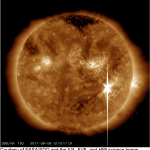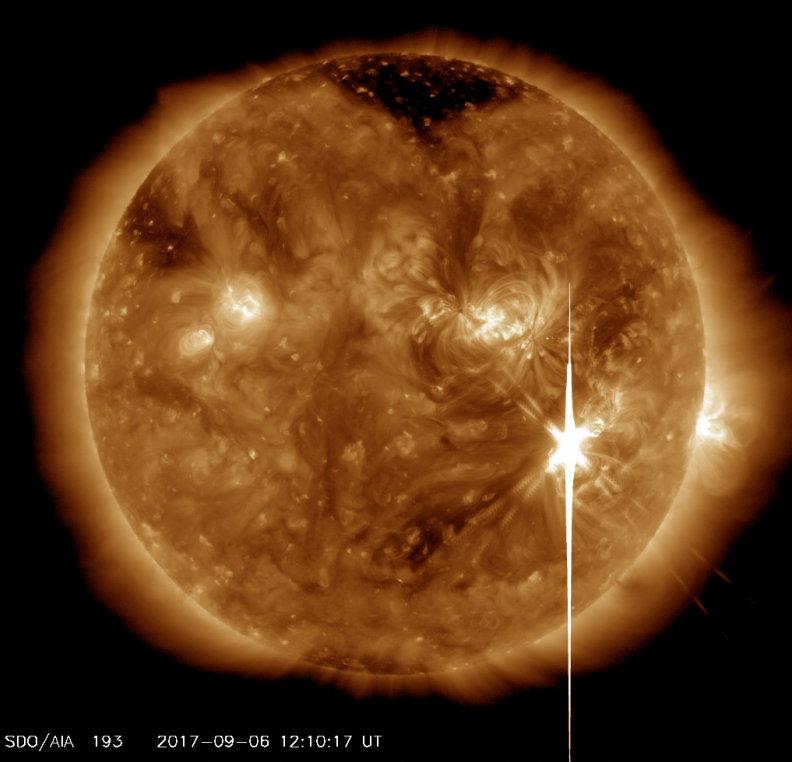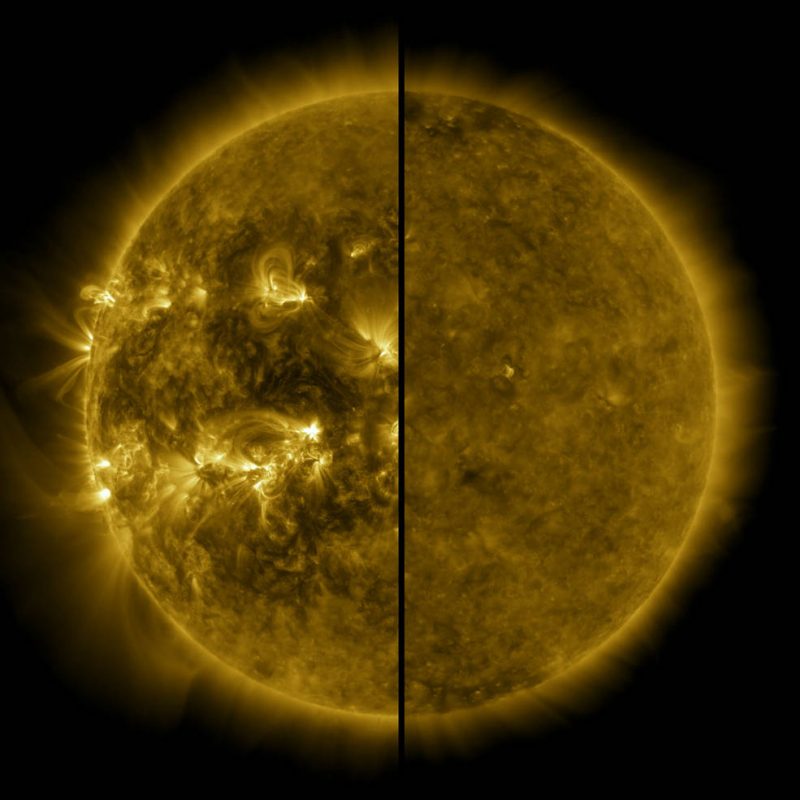

Image via NASA/ SDO/ AIA, EVE, HMI science teams.
By Graham Jones
Solar flares are brief eruptions of intense high-energy radiation from the sun’s surface. They’re associated with sunspots, coronal mass ejections and other signs of high activity on the sun, during its 11-year cycle. Activity on the sun creates what’s known as space weather, which can have an impact here on Earth. For example, a big solar flare can result in charged particles hurled toward Earth that cause disturbances in the power grid, satellites, GPS and airlines. But understanding when and why these powerful solar flares happen is one of most difficult challenges in astrophysics.
Now, a team of researchers in Japan think they may have found a way to predict large solar flares and make better forecasts of space weather. Kanya Kusano, Director of the Institute for Space-Earth Environmental Research, Nagoya University, and his team developed a physics-based model to predict imminent large solar flares. The study was published in the journal Science on July 31, 2020. Kusano spoke about about work.
What is the Institute for Space-Earth Environmental Research, and what’s your role?
Kanya Kusano: The human environment is so extended, it even spreads into space. Our institute was established in 2015 to combine space science and Earth science. My background is in astrophysics, but I used to work for the Japan Agency for Marine-Earth Science and Technology, where I developed simulations of clouds and rainfall. I’m a theoretician, but I always try to apply theory to some kind of practical benefit. Space weather forecasting is a field where basic science and practical application should be combined.
What is a solar flare?
It’s a kind of explosion. The driving force is the energy stored in the Sun’s magnetic field. This magnetic energy builds up slowly over a very long time, but is then suddenly released as radiation and high-energy particles. It’s just like an avalanche on a mountain: the snow accumulates over many days until the gravitational energy is released in an avalanche.
Why do we study solar flares?
The first reason is that phenomena that occur suddenly are very interesting science subjects. What determines the onset of an explosion? A typhoon, which grows quickly from a low pressure system, is another example of an explosion in an atmospheric system. The second reason is to protect our society. The distribution of solar flares is similar to earthquakes: we have many small solar flares, and a big one is very rare. However, when a big flare occurs, the impact on our economy and society may be enormous. Satellites may be damaged, and the power grid may be damaged over a very wide area. The only way to mitigate such kind of impact is prediction.

The sun’s activity runs on a roughly 11-year cycle, moving regularly from its most quiet period – solar minimum – to its most active – solar maximum – and back to quiet. This split image shows the difference between an active sun during solar maximum (on the left, captured in April 2014) and a quiet sun during solar minimum (on the right, captured in December 2019). December 2019 marks the beginning of Solar Cycle 25, and the sun’s activity will once again ramp up until solar maximum, predicted for 2025. Image via NASA/ Solar Dynamics Observatory (SDO).
Why has it taken so long to come up with a way to predict solar flares?
Solar flares were discovered in 1859 by Carrington, a British astronomer, and people studied them for more than a hundred years. But in the last two or three decades our knowledge has improved enormously because of very high resolution observations by satellite. We now understand that a solar flare is an explosion of magnetic energy. However, what determines when the solar flare occurs? That is still a mysterious problem.
How are you solving this problem?
NASA’s Solar Dynamics Observatory (SDO) satellite provides magnetic data on the solar surface. It is impossible to directly observe the magnetic field in three dimensions, so we have developed software which can calculate the three-dimensional field from the surface data. Then we combine this with theory. Instability of the magnetic field is triggered by magnetic reconnection, where the field lines swap around. If we can find some position where a small amount of magnetic reconnection could trigger instability, then we can predict that a big flare should start from there. It is similar to that avalanche. If you have thick snow on a mountain, theory can tell us how small a crack could trigger an avalanche at any position.
Your latest paper is a proof of concept. How long will it be before you can start making forecasts?
Currently our scheme requires a big, heavy calculation. We use a supercomputer here in Japan. However, in order to produce one prediction, more than three hours of computation is required. It also takes more than several hours to get the SDO satellite data. In order to make practical, operational forecasts we have to accelerate the data acquisition and computation. I believe that within a couple of years we can make some kind of operational forecast using our scheme.
Do you worry about a big solar flare happening?
I really worry about an extreme event. We want to protect our society from a space-weather disaster. Our scheme can predict a solar flare several hours before the onset of the flare, but we cannot predict a solar flare in the next week. There are many such kinds of risks we should be concerned about in our society. And maybe science is the only way to think about them.

Kanya Kusano
Source: A physics-based method that can predict imminent large solar flares
Bottom line: How close are we to a space weather forecasting system that can provide early warning of a large solar flare?
from EarthSky https://ift.tt/2Gm3xYi


Image via NASA/ SDO/ AIA, EVE, HMI science teams.
By Graham Jones
Solar flares are brief eruptions of intense high-energy radiation from the sun’s surface. They’re associated with sunspots, coronal mass ejections and other signs of high activity on the sun, during its 11-year cycle. Activity on the sun creates what’s known as space weather, which can have an impact here on Earth. For example, a big solar flare can result in charged particles hurled toward Earth that cause disturbances in the power grid, satellites, GPS and airlines. But understanding when and why these powerful solar flares happen is one of most difficult challenges in astrophysics.
Now, a team of researchers in Japan think they may have found a way to predict large solar flares and make better forecasts of space weather. Kanya Kusano, Director of the Institute for Space-Earth Environmental Research, Nagoya University, and his team developed a physics-based model to predict imminent large solar flares. The study was published in the journal Science on July 31, 2020. Kusano spoke about about work.
What is the Institute for Space-Earth Environmental Research, and what’s your role?
Kanya Kusano: The human environment is so extended, it even spreads into space. Our institute was established in 2015 to combine space science and Earth science. My background is in astrophysics, but I used to work for the Japan Agency for Marine-Earth Science and Technology, where I developed simulations of clouds and rainfall. I’m a theoretician, but I always try to apply theory to some kind of practical benefit. Space weather forecasting is a field where basic science and practical application should be combined.
What is a solar flare?
It’s a kind of explosion. The driving force is the energy stored in the Sun’s magnetic field. This magnetic energy builds up slowly over a very long time, but is then suddenly released as radiation and high-energy particles. It’s just like an avalanche on a mountain: the snow accumulates over many days until the gravitational energy is released in an avalanche.
Why do we study solar flares?
The first reason is that phenomena that occur suddenly are very interesting science subjects. What determines the onset of an explosion? A typhoon, which grows quickly from a low pressure system, is another example of an explosion in an atmospheric system. The second reason is to protect our society. The distribution of solar flares is similar to earthquakes: we have many small solar flares, and a big one is very rare. However, when a big flare occurs, the impact on our economy and society may be enormous. Satellites may be damaged, and the power grid may be damaged over a very wide area. The only way to mitigate such kind of impact is prediction.

The sun’s activity runs on a roughly 11-year cycle, moving regularly from its most quiet period – solar minimum – to its most active – solar maximum – and back to quiet. This split image shows the difference between an active sun during solar maximum (on the left, captured in April 2014) and a quiet sun during solar minimum (on the right, captured in December 2019). December 2019 marks the beginning of Solar Cycle 25, and the sun’s activity will once again ramp up until solar maximum, predicted for 2025. Image via NASA/ Solar Dynamics Observatory (SDO).
Why has it taken so long to come up with a way to predict solar flares?
Solar flares were discovered in 1859 by Carrington, a British astronomer, and people studied them for more than a hundred years. But in the last two or three decades our knowledge has improved enormously because of very high resolution observations by satellite. We now understand that a solar flare is an explosion of magnetic energy. However, what determines when the solar flare occurs? That is still a mysterious problem.
How are you solving this problem?
NASA’s Solar Dynamics Observatory (SDO) satellite provides magnetic data on the solar surface. It is impossible to directly observe the magnetic field in three dimensions, so we have developed software which can calculate the three-dimensional field from the surface data. Then we combine this with theory. Instability of the magnetic field is triggered by magnetic reconnection, where the field lines swap around. If we can find some position where a small amount of magnetic reconnection could trigger instability, then we can predict that a big flare should start from there. It is similar to that avalanche. If you have thick snow on a mountain, theory can tell us how small a crack could trigger an avalanche at any position.
Your latest paper is a proof of concept. How long will it be before you can start making forecasts?
Currently our scheme requires a big, heavy calculation. We use a supercomputer here in Japan. However, in order to produce one prediction, more than three hours of computation is required. It also takes more than several hours to get the SDO satellite data. In order to make practical, operational forecasts we have to accelerate the data acquisition and computation. I believe that within a couple of years we can make some kind of operational forecast using our scheme.
Do you worry about a big solar flare happening?
I really worry about an extreme event. We want to protect our society from a space-weather disaster. Our scheme can predict a solar flare several hours before the onset of the flare, but we cannot predict a solar flare in the next week. There are many such kinds of risks we should be concerned about in our society. And maybe science is the only way to think about them.

Kanya Kusano
Source: A physics-based method that can predict imminent large solar flares
Bottom line: How close are we to a space weather forecasting system that can provide early warning of a large solar flare?
from EarthSky https://ift.tt/2Gm3xYi

Aucun commentaire:
Enregistrer un commentaire